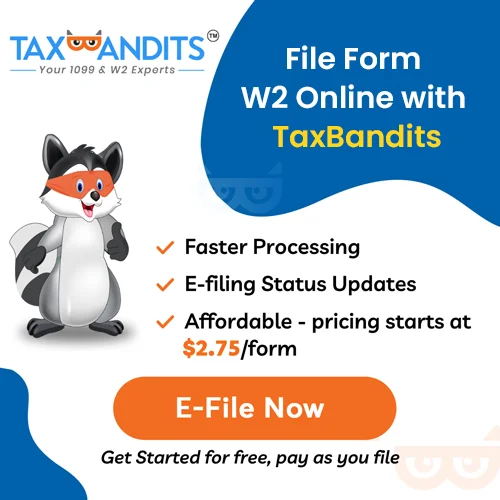E-File Now
Form W2 vs W4 - An Overview
Updated on October 04, 2024 - 04:00 PM by Admin, TaxBandits
Form W-2 and Form W-4 are essential tax documents commonly used by both employers and employees. Each of these forms serves a distinct purpose, addressing various aspects of tax compliance. The Form W-4 is filled out by the employee and then shared with their employer to specify the amount of taxes that should be deducted from their paycheck for tax purposes. Whereas the W-2 Form is completed by the employer and indicates the employee’s annual income and the corresponding taxes that were withheld. In addition to providing the employee with a copy, the employer must also file the W-2 with the Social Security Administration (SSA) at the end of the year.
Understanding the difference between Form W-2 and Form W-4 is crucial, especially for business owners that hire employees. In this article, we will explain the difference between Form W-2 and W-4 and when it should be
completed or filed.
Table of Contents:
- What is a W-2?
- What is a W-4?
- What is a W-4 Withholding allowance?
- Form W2 vs W4: What's the difference?
- When is the Deadline to File W2 & W4?
- Does an independent contractor have to fill out a W-4?
- Form W2 vs W4: Who is eligible for filling out these forms?
- What Form Should Independent Contractors Use?
- How many allowances can an employee claim on their W-4?
- How to file Form W-2 with TaxBandits?
1. What is a W-2?
Form W-2 is an employee’s Wage and Tax Statement, used to report the wages and income taxes withheld from the employee's paycheck during the year. The W-2 records information such as employee wages, tips, other compensation, Federal income taxes, Social Security and Medicare tax withheld. Typically, employers are required to fill out Form W-2 and distribute it to each employee and the SSA at the end of each year.
2. What is a W-4?
Form W-4, also called Employee's Withholding Certificate, is generally filled out by every new employee to indicate the amount of Federal tax their employer should withhold from their wages during the year (Social Security (SS) and Medicare taxes are fixed rates so the W-4 has no bearing on those taxes).
The withholding amount reported on the Form W-4 is based on the
- Employee filing status, such as single, married, filing jointly, or head of household.
- Number of withholding allowances such as dependents, anticipated tax credits, and deductions.
If any of the conditions mentioned above, such as a change in filing status or an increase in dependents, occur during the year, employees should promptly provide an updated Form W-4 to their employer. This ensures that the withholding accurately reflects their current tax situation.
3. What is a W-4 Withholding allowance?
Withholding allowance in Form W-4, referred to as an exemption that reduces the Federal tax withholding from an employee's wages. The more withholding allowances claimed, the less income tax will be withheld from a paycheck.
4. Form W2 vs W4: What's the difference?
Form W-2 and W-4 are both tax documents that employers and employees use for accurate employment tax reporting. While they are closely related, they each serve different purposes. Here are the key differences between Form W-2 and W-4.
| Aspect | Form W-2 | Form W-4 |
|---|---|---|
|
Purpose |
Form W-2 is used to report the employee’s wages and tax withheld from the employee's paycheck during the year. |
Form W-4 provides information about the amount of taxes employers need to withhold from the employee's wages during the year. |
|
Who Completed the Form? |
Form W-2 is filled out by Employers. |
Form W-4 is filled out by Employees. |
|
When to complete the Form? |
Employers should complete the Form W-2 and distribute it to each employee and SSA at the end of |
Employers should collect Form W-4 from new employees as part of the onboarding process. Employees should fill out a new W-4 to inform their employer about any personal or financial changes that might impact tax withholding. |
Scenario: When a new employee is hired, they are required to complete Form W-4. This form provides essential personal information and specifies their withholding allowances. Employers then use the data from Form W-4 to determine the correct amount of Federal tax to withhold from the employee's wages throughout the year. At the end of the year, employers use Form W-2 to compile and report the employee's annual wages and the taxes that have been withheld from their paychecks. This information is submitted both to the IRS and provided to the employees for tax reporting purposes.
5. When is the Deadline to File Form W-2 and W-4?
The deadlines for Form W-2 and Form W-4 are different:
Form W-2 Deadline: Employers are required to file W-2 to the SSA and each employee before January 31st of the following year. This means that employees should receive their Form W-2, which summarizes their earnings and tax withholdings for the previous year, by the end of January.
Form W-4 Deadline: Form W-4 should ideally be completed by a new employee shortly after they start their job. It's important to provide this information to the employer as soon as possible to ensure accurate tax withholding throughout the year. However, there is no specific annual deadline for Form W-4 unless an employee's personal or financial situation changes during the year, in which case they should update their Form W-4 promptly.
6. Does an independent contractor have to fill out a W-4?
Independent contractors are not required to fill out Form W-4. Instead, they are typically requested to complete Form W-9, also known as the Request for Taxpayer Identification Number and Certification, at the beginning of the contract. This form is used to provide their Taxpayer Identification Number (TIN) information to the payer for the purpose of reporting 1099 forms at the end of the year.
7. Form W2 vs W4: Who is eligible for filling out these forms?
Businesses and employees (Regular payroll employees) are required to fill out Form W-2 and W-4. Employers use the W2 form to report employees' annual wages and the amount of taxes withheld from their paychecks. Employees, on the other hand, are responsible for completing the W-4 form, which provides employers with the necessary information for withholding the appropriate amount of federal income tax from their wages.
8. What Form Should Independent Contractors Use?
Independent contractors have distinct tax obligations compared to W-2 employees. Unlike W-2 employees, federal taxes are not withheld from an independent contractor's paycheck, and employers should use Form 1099 to report their income to the IRS.
When engaging the services of an independent contractor, employers are tasked with requesting a completed Form W-9 from the contractor instead of the Form W-4, which is used for employees. Form W-9 serves a similar purpose to Form W-4 by gathering essential information, including the contractor's Taxpayer Identification Number (TIN), and withholding details.
9. How many allowances can an employee claim on their W-4?
An employee can claim anywhere from 0 to 3 allowances on their W-4 form. The number of allowances claimed directly impacts the amount withheld from the paycheck. Claiming zero or a lower number of allowances typically results in higher income withheld. The determination of withholding allowances is influenced by several factors, including marital status and income level, with the value of allowances being based on the tax bracket
and pay frequency.
If there are changes in an individual's circumstances, such as getting a second job or getting married, it is advisable to submit a new W-4 form to ensure accurate withholding.
10. How to file Form W-2 with TaxBandits?
E-file your Form W-2 with TaxBandits in a few simple steps and get instant IRS updates. TaxBandits is an IRS-authorized e-file provider offering an e-filing solution for various forms, including Form W-2, 1099s, 94x, and ACA forms. We offer premium features such as bulk filing to submit multiple returns, internal audits to ensure accurate filing, and more. We support e-filing for both federal and state purposes, allowing you to distribute recipient copies either through postal mail or online access.


